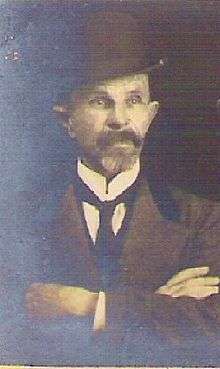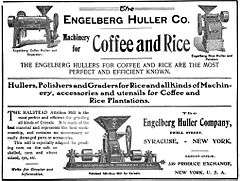Evaristo Conrado Engelberg
| Evaristo Conrado Engelberg | |
|---|---|
 | |
| Born |
October 26, 1853 Piracicaba, São Paulo, Brazil |
| Died |
1932 Piracicaba, São Paulo, Brazil |
| Occupation | mechanical engineer, inventor and businessman |
Evaristo Conrado Engelberg (26 October 1853 – 1932) was a Brazilian mechanical engineer and inventor.[1] He is the inventor of the Engelberg huller, a machine used to strip the husks from rice and coffee during the milling process.[2] He was born to German immigrants in Piracicaba, São Paulo, Brazil.[1]
Biography
Invents rice and coffee peeler
In 1885,[3] while constructing a water wheel, Engelberg observed a group of slaves stripping the hulls from rice with pestles by hand, the main method of cleaning rice at the time. Engelberg experimented with the method and found that by rubbing the rice between his fingers while applying pressure, the hulls were easily removed. He returned to his workshop and immediately began working on a machine that he finished the next day, thus creating the first horizontal cylinder rice "peeler." The invention was named the Engelberg Huller and soon was adapted to work with coffee. Once it made it to market, the device revolutionized the processing of coffee and rice throughout the world.
Brazilian manufacturing
There was some initial resistance to the machine from ranchers and farmers in Brazil, who preferred to use slave labor throughout the year for these and other processes, rather than investing the money in the machines invented by Engelberg, which would be useful only during harvest. Despite this initial resistance, the peelers was eventually adopted by major growers of the region. With the strong development of his business, in June 1885, Engelberg partnered with Earl Siciliano to found Engelberg & Siciliano which was headquartered in Piracicaba.[4]
Patents for coffee huller
During 1885, Engelberg received a British patent for a rice-hulling machine.[5]
Three years later, on December 27, 1888, Engelberg applied for a United States patent on the coffee-hulling machine.[3] U.S. patent (number 424,602) for a rice-hulling machine, was granted on April 1, 1890.[6] With this machine, hulling and polishing, which removes different layers below the husk, could be done in several stages "during the same passage," a process that automated a manual task.[2]
In 1890, the Gazeta de Piracicaba reported that Engelberg was appointed a member of the Parisian Academy of Inventors, and awarded a gold medal for his invention. Engelberg patented several models of these machines in the United States and Europe. He enjoyed huge success, because the "stripper" did not squeeze the coffee beans, and removed all the straw while maintaining the beans' integrity, producing a higher yield for coffee growers. The maintenance of the machines was also quite simple and inexpensive, which was advantageous, because the main methods of cleaning the coffee still depended on slave labor in mills.[4]
U.S. manufacturing

During 1888, as international demand for his machine increased, Engelberg partnered with José Tibiriçá to create a branch of his company in Syracuse, New York, known as the Engelberg Huller Company, which was organized for the purpose of manufacturing and selling the "Engelberg huller".[3] in North America. The huller was quite successful, and additional patents were granted to the firm for various improvements over the years.[5]
Production in Brazil was halted in 1890 and by 1922, the machines produced in Syracuse began to be shipped and sold in Brazil, as well as other parts of South America, Asia, Africa and Central America.[7]
At some time during the twentieth century the Engelberg Huller Company began to make grinders plus belt and disk sanders, all intended primarily for metalworking. Some time between 1957 and 1971, the company name was shortened to Engelberg, Inc. and by 1971 the name was amended, to Sundstrand-Engelberg, Inc. of Liverpool, New York. During 1974, the name changed to Sundstrand Syracuse, Inc. of Syracuse, New York, and Sundstrand Corp. of Rockford, Illinois.[5]
Invention still in use today
By 1990, Engelberg hullers were still widely used in small mills for milling rice for local markets.[2] As of 2011, the Syracuse-based branch of the Engelberg Huller Company continues to produce hullers. The associated parts and the hullers are still in use in many parts of the world.[5]
References
- 1 2 "Rua Evaristo Conrado Engelberg". História das Ruas de São Paulo, 1991. Retrieved July 17, 2011.
- 1 2 3 Peter R. Lawrence; K. Lawrence; J. T. Dijkmann; P. H. Starkey. Research for development of animal traction in West Africa. Nigeria: West Animal Traction Network, July 1990. Retrieved July 17, 2011.
- 1 2 3 "A Coffee Chronology". Webbooks, 2011. Retrieved July 17, 2011.
- 1 2 "Um piracicabano na Academia de Paris". A Provincia, October 11, 2009. Retrieved July 17, 2011.
- 1 2 3 4 "Engelberg, Inc.". Vintage Machinery, 2011. Retrieved July 17, 2011.
- ↑ "Patents for Engelberg Huller Co.". Directory of American Tool and Machinery Patents, 2011. Retrieved July 17, 2011.
- ↑ "Inventions Built Industries Here". Syracuse Journal. Syracuse, New York. March 20, 1939.
- Cochran Co,John C. "The American exporter", Volume 102, 1928, p. 177.
- Dean,Warren. "A industrialização de São Paulo / The Industrialization in Sao Paulo", Record,USP, 1971, p. 18
- Mukerji,Niya Gopal,"Handbook of Indian Agriculture", Printwell Publishers, 1990, p. 185
- Kano."Research for development of animal traction in West Africa:proceedings of the Fourth Workshop of the West Africa Animal Traction Network", Nigeria, 1990, p. 49,50,51
- Lahmeyer Lobo,Eulália Maria. "História político-administrativa da agricultura brasileira:1808-1889" - Resenhas, 1977, p 93,98
- Instituto Brasileiro do Café. "Ensaios sobre café e desenvolvimento econômico", 1973, p 37
- Boletim geográfico,Edições 196-201. Instituto Brasileiro de Geografia, Brasil. Conselho Nacional de Geografia [Departamento de Documentação e Divulgação Geográfica e Cartográfica], 1967, p 71.
External links
- Hand book of Indian agriculture, Volume 1
- THE ENGELBERG HULLER
- Consulta Histórico de Logradouros
- PREPARING GREEN COFFEE FOR MARKET -A COFFEE CHRONOLOGY
- Máquina beneficiadora de café
- Read the ebook All about coffee by William H. (William Harrison) Ukers
- A Província - Paixão por Piracicaba
- OWWM - Engelberg, Inc. - Assigned Patents